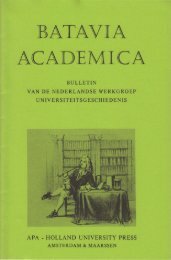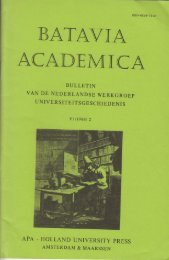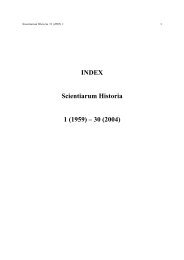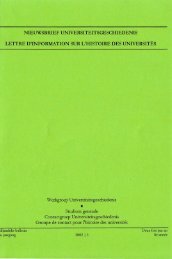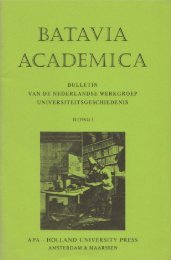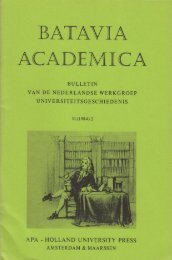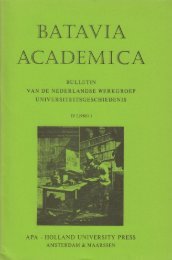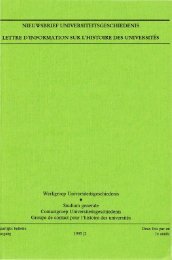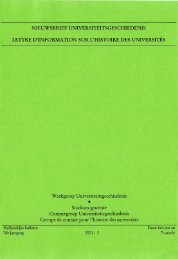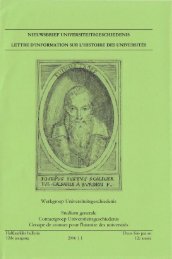the ocular harpsichord of louis-bertrand castel - Gewina
the ocular harpsichord of louis-bertrand castel - Gewina
the ocular harpsichord of louis-bertrand castel - Gewina
You also want an ePaper? Increase the reach of your titles
YUMPU automatically turns print PDFs into web optimized ePapers that Google loves.
The first announcement <strong>of</strong> <strong>the</strong> <strong>ocular</strong> <strong>harpsichord</strong><br />
Castel's <strong>ocular</strong> <strong>harpsichord</strong> 19<br />
It was in this context that <strong>the</strong>re appeared in <strong>the</strong> Mercure de France <strong>of</strong> November<br />
1725 a letter from Castel directed to <strong>the</strong> o<strong>the</strong>rwise unknown Monsieur Decourt<br />
<strong>of</strong> Amiens, entitled "Clavecin pour les yeux, avec Part de peindre les sons, et<br />
toutes sortes de pieces de musique.""* In this letter, Castel set out to prove that<br />
<strong>the</strong>re was an analogy between <strong>the</strong> phenomena <strong>of</strong> sound and light, and between<br />
tones and colours, such that what had up till <strong>the</strong>n been performed only with<br />
sound, that is, arranging different tones in such a way that we appreciate <strong>the</strong><br />
effect as a form <strong>of</strong> art, should be equally possible by arranging different colours,<br />
so that a whole new form <strong>of</strong> art would emerge, a music <strong>of</strong> colours.<br />
Castel motivated <strong>the</strong> analogy between .sound and light by <strong>the</strong> supposition that<br />
both were vibrational phenomena. By way <strong>of</strong> a rhetorical question he wondered<br />
whe<strong>the</strong>r "sound and light do not equally consist in <strong>the</strong> insensible wigglings <strong>of</strong> <strong>the</strong><br />
sonorous and luminous bodies, and <strong>of</strong> <strong>the</strong> media that transmit <strong>the</strong>m to our ears<br />
[and to our eyes]?"'" And as tones are modifications <strong>of</strong> sound and colours are<br />
modifications <strong>of</strong> light, this implied an analogy between tones and colours. For<br />
arguments for this view he did not refer to one <strong>of</strong> <strong>the</strong> <strong>the</strong>n current light <strong>the</strong>ories<br />
<strong>of</strong> Newton, Malebranche or Descartes, but to <strong>the</strong> work <strong>of</strong> his Jesuit predecessor<br />
Athanasius Kircher, whom Castel on a later occasion called "my true, my first,<br />
and as it were my only master"." From Kircher Castel derived a number <strong>of</strong><br />
observational analogies between sound and light: <strong>the</strong>y both are reflected by<br />
plane surfaces; both can penetrate into denser media and are refracted in <strong>the</strong><br />
process; and both can be concentrated in a focus by a hollow mirror. Moreover,<br />
<strong>the</strong> speaking trumpet or ear trumpet, Kircher's own invention, seemed <strong>the</strong><br />
perfect analogue <strong>of</strong> <strong>the</strong> telescope. These observations sufficiently supported <strong>the</strong><br />
hypo<strong>the</strong>sis that sound and light were manifestations <strong>of</strong> <strong>the</strong> same kind <strong>of</strong> physical<br />
process.<br />
It was already Kircher who had concluded that, if this were true, <strong>the</strong>re had to<br />
be an analogy between <strong>the</strong> art forms <strong>of</strong> tone and colour. According to Kircher:<br />
"If, when a musical instruments sounds, someone would perceive <strong>the</strong> finest<br />
movements <strong>of</strong> <strong>the</strong> air, he certainly would see nothing but a painting with an<br />
extraordinary variety <strong>of</strong> colours." And again: "The colours also have <strong>the</strong>ir<br />
harmony, which pleases no less than music, and this analogous harmony even<br />
"* Mercure dc France, November 1725, pp. 2552-2577.<br />
Ibid., p. 2557: "le son & la lumiere ne consistent-ils pas egalement dans les tremou-ssemens<br />
insensibles des corps sonores & lumineux. & du milieu qui les transmet jusqu'a nos oreilles?"<br />
Memoires de Trewtix. October 17.35, p. 2033: "mon veritable, mon premier, & comme mon<br />
unique Maitre".



